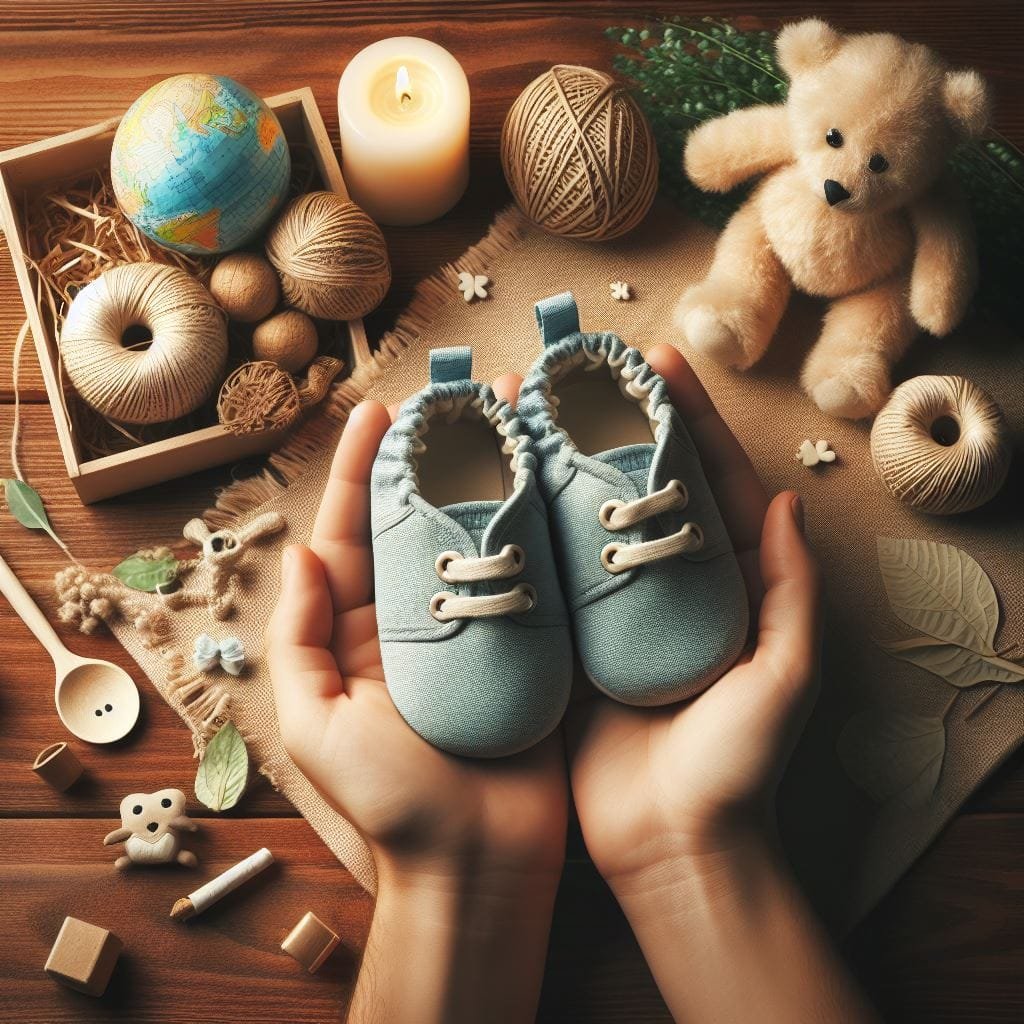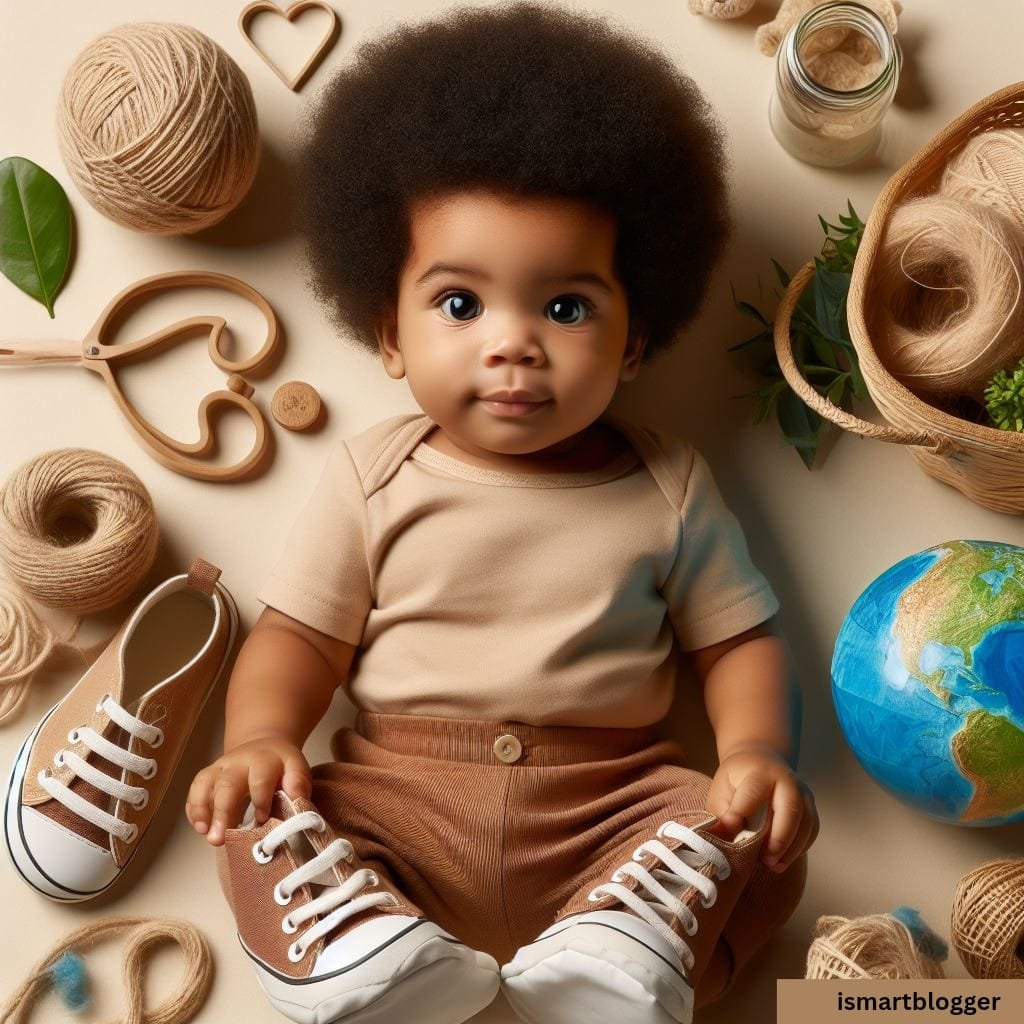Introduction to Sustainable Baby Footwear
The Tiny Footprints of Big Change
Babies: they are the epitome of innocence, joy, and vulnerability. As parents, we strive to provide them with the utmost care and protection from the world’s harsh realities. This includes making conscious choices that positively impact their future.
One such choice is sustainable baby footwear. By opting for eco-friendly and ethically produced shoes for our little ones, we not only safeguard their delicate feet but also contribute to a greener and more compassionate world.
A Peek into the Baby Footwear Industry
Before diving into the realm of sustainable baby footwear, let’s take a moment to understand its broader landscape. The baby footwear industry is an ever-evolving market catering to the tiny toes that wiggle with glee. From adorable booties to snug sneakers, there is an array of options available for those miniature feet.
Traditionally, this industry has been driven by conventional materials and manufacturing practices that often prioritize profit over sustainability or ethical considerations. However, in recent years, there has been a notable shift towards more responsible alternatives due to increased awareness about environmental issues and social injustices.
Nowadays, parents are seeking out brands committed to reducing their carbon footprint while ensuring safe and healthy shoes for their little ones. With sustainability at its core, this emerging niche within the baby footwear market offers a ray of hope – providing stylish yet planet-friendly choices that resonate with conscientious consumers.
Intriguingly enough, sustainable baby footwear goes beyond simply being fashionably green; it also encompasses aspects such as non-toxicity and proper support for growing feet. So let’s delve deeper into why these qualities matter so much when it comes to our precious bundles of joy.

Understanding Sustainability in Baby Footwear
Definition and Principles of Sustainability
When we talk about sustainability in the context of baby footwear, we refer to the use of materials and manufacturing processes that minimize negative impacts on the environment and prioritize the well-being of future generations. It goes beyond simply creating cute shoes; it’s about making conscious choices that contribute to a healthier planet.
Sustainable baby footwear embodies principles such as using eco-friendly materials, reducing carbon footprint, promoting ethical manufacturing practices, and ensuring non-toxic options for little feet. Sustainable baby footwear aims to strike a delicate balance between style, functionality, and environmental responsibility.
It’s not only about what materials are used but also how they are sourced, manufactured, and disposed of. By promoting sustainable practices in the industry, we pave the way for a brighter future for our children.
Environmental Impact of Conventional Baby Footwear
The conventional baby footwear industry often relies on synthetic materials derived from petrochemicals like PVC (polyvinyl chloride) or other plastics. These materials have a significant environmental impact throughout their life cycle.
Production processes release harmful pollutants into the air and waterways, contributing to pollution and climate change. Moreover, conventional shoes often contain toxic chemicals such as phthalates or lead that can be absorbed through a baby’s delicate skin or inadvertently ingested through hand-to-mouth contact.
These substances have been linked to adverse health effects like developmental disorders or hormone disruption. The mass production and disposal of non-sustainable baby shoes also create mountains of waste that end up in landfills where they take decades to decompose fully.
This unsustainable cycle contributes significantly to our already overstressed landfill capacities. Understanding these environmental issues associated with conventional baby footwear highlights the need for sustainable alternatives that reduce harm to both nature and our precious little ones’ health.
Eco-friendly Materials for Baby Footwear
Organic Cotton and its Benefits
When it comes to sustainable baby footwear, organic cotton is a top choice for many parents. Unlike conventional cotton, which is grown with the use of harmful pesticides and synthetic fertilizers, organic cotton is cultivated using natural methods. This means that no toxic chemicals seep into the soil, waterways, or ultimately onto your baby’s delicate skin.
The benefits of organic cotton go beyond environmental preservation. It is hypoallergenic and gentle on sensitive skin, reducing the risk of irritation and allergic reactions.
Additionally, organic cotton fibers are breathable and soft, ensuring maximum comfort for your little one’s feet. So not only are you making an eco-conscious choice by opting for organic cotton footwear, but you’re also prioritizing your baby’s comfort and well-being.
Recycled Materials: Turning Waste into Adorable Shoes
Another exciting trend in sustainable baby footwear is the use of recycled materials to create stylish and eco-friendly shoes. This includes repurposing materials like recycled PET bottles or old textiles to give them a new lease on life as adorable baby shoes.
By utilizing recycled materials in their production process, these brands are diverting waste from landfills while minimizing the need for virgin resources. This reduces energy consumption and lowers carbon emissions associated with manufacturing new materials from scratch.
Not only do these recycled materials help conserve our planet’s resources, but they also make unique designs possible! Imagine your little one rocking a pair of sneakers made from upcycled denim or sandals created out of discarded fishing nets – it’s fashion with a purpose!
Plant-based Alternatives: Hemp, Bamboo, and More
In addition to organic cotton and recycled materials, plant-based alternatives offer another avenue for sustainable baby footwear choices. These alternatives often possess similar if not superior qualities compared to traditional materials.
For instance, hemp is gaining popularity due to its durability and its ability to grow quickly without the need for pesticides or excessive water usage. Hemp fibers are naturally antimicrobial, making them ideal for baby shoes that resist odor-causing bacteria.
Bamboo is another fantastic plant-based option thanks to its extraordinary renewability and fast growth. This versatile material has a soft and silky texture, providing exceptional comfort.
It also boasts natural moisture-wicking properties, keeping your baby’s feet cool and dry. Other plant-based alternatives include cork, which is lightweight and shock-absorbent, as well as Piñatex™ – a sustainable leather substitute made from pineapple leaf fibers.
These innovative materials not only reduce the environmental impact of baby footwear but also contribute to a more diverse market with unique textures and designs. Eco-friendly materials like organic cotton, recycled materials, and plant-based alternatives have revolutionized the world of sustainable baby footwear.
By choosing these options for your little one’s tiny feet, you’re making a positive impact on both their future and the planet’s well-being. So why settle for conventional when you can dress your baby in environmentally conscious yet stylish shoes?
Harmful Chemicals to Avoid in Baby Footwear
Subtitle: Protecting Your Little One’s Delicate Feet When it comes to choosing footwear for your precious bundle of joy, it’s crucial to be aware of the harmful chemicals that might lurk in conventional baby shoes.
Phthalates, lead, and other toxins are commonly found in materials used for manufacturing baby footwear. These substances can pose serious risks to your infant’s health and development.
Phthalates, often used as plasticizers, have been linked to hormone disruption and may interfere with reproductive system development. Lead, a heavy metal known for its toxicity, can impair brain development and cause cognitive and behavioral issues.
Other toxins like formaldehyde and flame retardants can also be found in typical baby footwear materials. Exposing your little one’s delicate skin to these harmful substances is something all parents should strive to avoid.
Potential Health Risks for Infants
Subtitle: Nurturing Healthy Steps from the Start Infants are particularly vulnerable to the effects of toxic chemicals due to their smaller body size, developing immune systems, and higher absorption rates through their skin.
Their bodies are still growing and developing rapidly, making them more susceptible to the negative impacts of exposure. Research has shown that infants who come into contact with phthalates or lead through their clothing or footwear may experience adverse health effects later in life.
The potential health risks include developmental delays, respiratory problems such as asthma or allergies, endocrine disruption leading to hormonal imbalances, and even increased risk of certain cancers. As caregivers entrusted with our little ones’ well-being, it is our responsibility to minimize these risks by carefully selecting non-toxic alternatives when it comes to their footwear choices.
Safer Alternatives: Natural Dyes and Water-Based Adhesives
Subtitle: Embracing Mother Nature’s Palette Thankfully, there are safer alternatives available in the realm of baby footwear that prioritize your little one’s health and well-being.
Natural dyes derived from plants, such as indigo or turmeric, provide vibrant and eco-friendly coloring options. These natural dyes eliminate the need for toxic synthetic dyes that may contain heavy metals or carcinogens.
Water-based adhesives offer a safer alternative to solvent-based adhesives commonly used in conventional shoe manufacturing. Solvent-based adhesives often contain volatile organic compounds (VOCs) that can emit harmful fumes.
In contrast, water-based adhesives are free from VOCs, reducing the risk of respiratory irritation for both babies and adults. By choosing baby footwear made with natural dyes and water-based adhesives, parents can ensure their little ones take their first steps in shoes that not only protect their feet but also support their overall health and development.
Ethical Manufacturing Practices in the Baby Footwear Industry
Fairtrade certifications and their significance
When it comes to sustainable baby footwear, ethical manufacturing practices play a crucial role. One way to ensure that the workers involved in the production process are treated fairly is through fair trade certifications.
These certifications provide consumers with the confidence that the shoes they are purchasing have been produced under ethical conditions. Fairtrade organizations closely monitor the entire supply chain, from raw material sourcing to manufacturing, to ensure fair wages and decent working conditions for all workers involved.
Ensuring fair wages for workers
Fair wages are an essential aspect of ethical manufacturing practices in the baby footwear industry. It means that every individual involved in making those adorable little shoes receives compensation that is fair and supports a decent standard of living.
Fairtrade organizations set standards for minimum wages, taking into account factors such as local living costs and prevailing wage rates. By supporting brands with fair trade certifications, you can contribute to creating a more equitable industry where workers are not exploited or underpaid.
Promoting safe working conditions
Another critical aspect of ethical manufacturing practices is promoting safe working conditions for factory employees. This includes providing proper training on occupational health and safety measures, ensuring access to personal protective equipment (PPE), and maintaining well-maintained facilities.
Ethical brands prioritize worker safety by enforcing guidelines that protect employees from any potential harm or accidents during production processes. By choosing sustainable baby footwear with ethical manufacturing practices, you can support brands that prioritize worker well-being and promote safer working environments.
Ethical considerations: child labor and exploitation
Child labor is an unfortunate reality in some industries around the world, including fashion and footwear manufacturing. However, by supporting brands with strong ethical commitments, you can help combat this issue within the baby footwear industry.
Ethical manufacturers take a zero-tolerance approach to child labor and undergo rigorous audits to ensure compliance. They actively work to prevent exploitation by implementing strict policies that prohibit the use of child labor in any stage of production.
By being conscious consumers and choosing sustainable baby footwear brands that prioritize ethical considerations, we can contribute to creating a world where all children are protected and given the opportunity to thrive. Ethical manufacturing practices in the baby footwear industry are vital for ensuring fair treatment of workers and promoting safe working conditions.
Fairtrade certifications offer consumers confidence that the shoes they purchase are produced under ethical circumstances, including fair wages for workers. Ethical brands prioritize worker safety by enforcing guidelines that protect employees from harm or accidents.
Additionally, they have strict policies against child labor, striving to create a world where all children are protected from exploitation. By supporting sustainable baby footwear with strong ethical commitments, we can make a positive impact on the industry and contribute to a more equitable and socially responsible future.
Sizing, Comfort, and Support in Sustainable Baby Shoes
Importance of proper fit for growing feet
Choosing the right size for your little one’s shoes is crucial in ensuring their comfort and overall foot health. Babies’ feet are constantly developing and growing, so it’s essential to provide them with footwear that allows for proper movement and development.
Ill-fitting shoes can lead to a range of issues such as blisters, and calluses, or even hinder their natural foot development. When shopping for sustainable baby shoes, be mindful of the sizing charts provided by the brand or manufacturer.
Take accurate measurements of your baby’s feet to find the perfect fit. Remember, a shoe that is too tight may restrict growth and cause discomfort, while one that is too loose may compromise stability.
Supportive features: arch support, cushioning, etc.
Supportive features play a significant role in providing comfort and stability to your baby’s growing feet. Look out for sustainable baby shoes that offer arch support as they help distribute weight evenly across the foot and promote healthy foot development. Cushioning is another essential aspect to consider as it provides shock absorption during walking or running activities.
Opt for shoes with cushioned insoles or padded collars that offer extra comfort. Additionally, flexible soles allow natural movement and aid in muscle development while protecting rough surfaces.
Adjustable closures: accommodating different foot shapes
Babies have unique foot shapes – some have wide feet while others have narrow ones – making adjustable closures an important feature in sustainable baby shoe design. Adjustable closures such as Velcro straps or elastic laces are not only convenient but also allow you to customize the fit according to your baby’s individual needs.
These closures ensure a secure fit without constricting their delicate feet or leaving too much room for slippage. Remember that babies’ feet grow quite rapidly, so it’s essential to check their shoe size periodically and adjust accordingly.
Don’t hesitate to seek professional advice if you are unsure about the fit. Investing in sustainable baby shoes that prioritize sizing, comfort, and support will not only keep your little ones’ feet happy but also contribute to their overall well-being as they embark on their exciting journey of exploration and discovery.
Caring for Sustainable Baby Footwear
Proper Cleaning Techniques to Prolong Shoe Life
Subtitle: Keeping Their Little Feet Fresh and Clean Babies have a knack for getting their adorable little feet into all sorts of messy situations. From mud puddles to food spills, their shoes can quickly become dirty and grimy.
But fear not! With the right cleaning techniques, you can keep your baby’s sustainable footwear looking fresh and smelling delightful.
For most sustainable baby shoes made from materials like organic cotton or recycled materials, hand-washing is the best approach. Fill a basin with lukewarm water and add a small amount of mild detergent specifically formulated for delicate fabrics.
Gently scrub the shoes using a soft brush or cloth, paying extra attention to any stubborn stains. Avoid using harsh chemicals or bleach as they may damage the shoe’s eco-friendly materials.
Once clean, rinse the shoes thoroughly with clean water to remove any soap residue. Then gently squeeze out excess water without wringing or twisting the shoes, as this could cause deformation.
To speed up drying, stuff them with paper towels or clean socks to absorb moisture properly. Place them in a well-ventilated area away from direct sunlight or heat sources that could warp or shrink the materials.
Storage Tips to Prevent Damage or Deformation
Subtitle: A Safe Haven for Tiny Shoe Treasures When it comes to storing your baby’s sustainable footwear collection, a little care goes a long way in preserving their shape and longevity. Here are some simple yet effective storage tips:
1. Find a dedicated shoe storage solution: Invest in a shoe rack designed specifically for babies’ small shoes that provide proper support without squishing them together. 2. Keep them dry: Ensure that your baby’s shoes are completely dry before storing them to prevent mold growth or unpleasant odors.
3. Use acid-free tissue paper: To maintain the shoe’s shape, gently stuff them with acid-free tissue paper or clean cotton socks to prevent any creasing or deformation. 4. Store shoes in a cool, dry place: Avoid storing the shoes in areas that are prone to high humidity or extreme temperature fluctuations, as this can damage the materials over time.
5. Rotate their footwear: Babies grow quickly, and their shoe size changes frequently. To ensure even wear and tear across multiple pairs of shoes, rotate them regularly so that no single pair is excessively worn.
Recycling Options When Shoes Are No Longer Usable
Subtitle: Giving Shoes a Second Chance As your baby outgrows their sustainable footwear or wears them out, it’s essential to consider environmentally responsible disposal options. Instead of simply tossing them into the trash bin where they will end up in landfills, explore these recycling options:
1. Donate to local charities: Many organizations accept gently used baby footwear for redistribution to families in need. Look for local charities or shelters that collect children’s clothing and shoes.
2. Host a shoe swap event: Organize a community gathering where parents can exchange their children’s outgrown shoes. This way, your baby’s beloved footwear can find new life with another little one.
3. Repurpose creatively: If the shoes are beyond repair or donation, get creative! Transform them into cute planters by filling them with soil and adding small plants like succulents.
You could also repurpose parts of the shoe as craft materials for DIY projects. By adopting these caring practices – proper cleaning techniques, thoughtful storage methods, and recycling options – you not only extend the life of your baby’s sustainable footwear but also contribute to minimizing waste and preserving our planet for future generations.
Trends in Sustainable Baby Footwear
Stylish Designs that Prioritize Sustainability
Sustainable baby footwear has come a long way from the plain, generic designs of the past. Today, eco-friendly brands are embracing style without compromising environmental consciousness. You can find an array of cute and trendy options for your little one’s tiny toes.
From vibrant organic cotton sneakers to adorable booties made from recycled materials, there is no shortage of stylish choices available. These designs not only prioritize sustainability but also ensure that your baby looks effortlessly fashionable while treading lightly on the planet.
Innovative Features like Biodegradable Soles
One of the most exciting developments in sustainable baby footwear is the introduction of biodegradable soles. Traditional shoe soles can take hundreds of years to break down in landfills, contributing to environmental pollution. However, eco-conscious brands have started using innovative materials such as plant-based compounds and bioplastics that naturally decompose over time.
These biodegradable soles not only reduce the carbon footprint but also provide excellent support and flexibility for developing feet. It’s heartening to see how technology and sustainability merge to create products that benefit both our children and the planet.
Conclusion
As we conclude our exploration into sustainable baby footwear trends, it becomes evident that choosing environmentally conscious options for our little ones is not just a fad but a responsible choice with long-lasting positive impacts. The marriage of style and sustainability has sparked a revolution in the industry, offering parents an extensive range of adorable designs while prioritizing ethical manufacturing practices and eco-friendly materials. By opting for sustainable baby footwear, we can instill values of conscious consumption in our children from an early age. Moreover, supporting brands that uphold these principles helps promote innovation and pushes more companies toward adopting eco-friendly practices. Together, we can create a brighter future where style and sustainability coexist harmoniously, ensuring that the next generation grows up with a deep appreciation for both fashion and the health of our planet.





